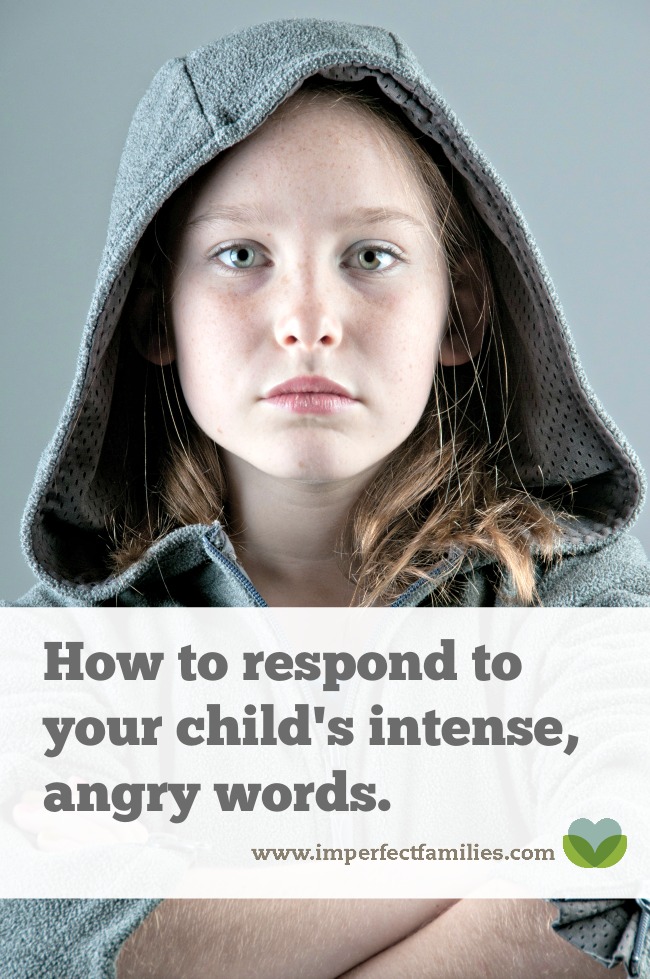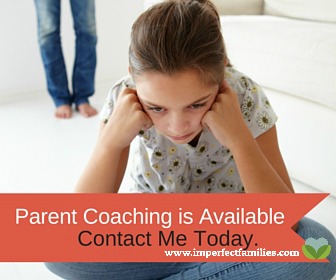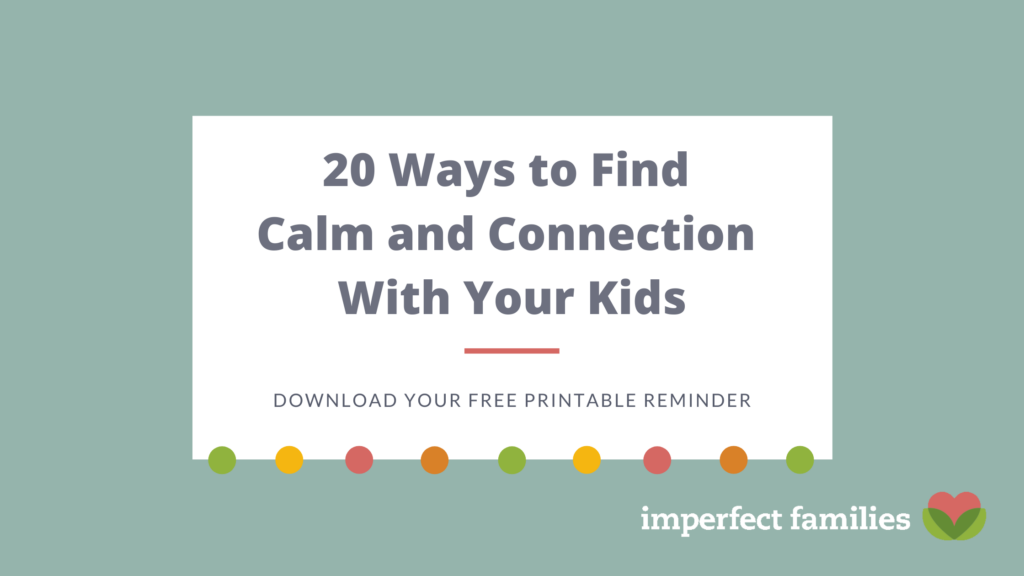
The kicking on the back of your seat is getting more intense.
“That’s enough!” you say, glancing at the grimacing face in the back seat.
“You can’t make me!” she responds, kicking harder now.
Your muscles tense. You hold your breath. You want to scream, “Oh, I can too make you stop. Don’t tempt me.” But you don’t. You know it will only make things worse.
Only 5 miles to home.
You can make it. Right?
Intense kids. Intense words.
It’s not uncommon to hear any mix of rude, insulting, and even confusing things when our kids are upset.
If you react, you’re met with a comeback.
If you ignore, you’re begged back into the conversation.
If you try to stop it, you only hear it more frequently.
How to Respond to Your Child’s Angry Words
- First, as the adult, take a look at your own stuff. Identify any thoughts, triggers or responses that come up in your own body when you hear particular words.
- Next, refuse to engage in similar behavior. Decide not to meet sarcasm with sarcasm or to try to engage in a back and forth battle about how illogical your child is in the moment.
- Finally, look beyond the behavior. Sure, your child could have used their words to eloquently express how they feel in the moment, but they didn’t. Instead of expecting more of your child, commit to helping them learn how to identify and communicate their needs and feelings differently next time.
5 Examples of Angry Words and How to Respond
Here are 5 common angry phrases you may hear from your child, what they may actually be trying to say, what you can do in each situation, and how to talk about it once everything has returned to calm.
“Leave me alone”
- What it means: “I’m so overwhelmed by my big emotions. I’m embarrassed and ashamed of the things I’ve done that I don’t want you to see me in this vulnerable state.”
- What you can do: Stay close. Do not walk away or ignore their big feelings or behaviors. Bring them out of their shame by reminding them that they are loved and that you are there to help. It’s ok to put some distance between you to keep everyone safe, but do it in a low-energy way, “I’m going to sit over here” or “I’m not going to let you hit the dog.”
- How to talk about it: Some kids actually do want to be alone. And some kids think they want to be alone, but once they are alone, they feel even more isolated and ashamed. In a calm moment, have a conversation with your child about what they need when big feelings surface. If they do want time alone, can you check in every few minutes? If they don’t want to be alone, how can they express this with a more straightforward phrase?
“I hate you” (or my sister, brother, best friend, etc.)
- What it means: “You (or the other person) hurt my feelings in a deep, deep way. Now, my emotions are so big, I can’t think of a better way to describe them to you!”
- What you can do: Let this one slide. Your child doesn’t need a lecture about how she “actually does love you.” She also doesn’t need a laundry list of the things you have done for her. Identify and manage your own triggers so you can be empathetic to the big feelings underneath the hurtful comment.
- How to talk about it: Your child may be expressing some valid points in the midst of their anger. Open up the conversation and give them a safe place to express their frustration or annoyance with you, a sibling, or a friend. Empathize with their feelings. Then, help them put their actual feelings into more accurate words, “It hurts my feelings when my friends break plans with me. I feel left out and sad. Part of me wants to hurt them because they have hurt me so badly.”
“I don’t know how to calm down!”
- What it means: “These feelings are way too big and way too scary. I’m worried that any calming strategy won’t work and I will feel this way forever.”
- What you can do: Calm yourself first. Focus more on keeping yourself in a calm frame of mind than getting your child to calm down. If it seems like an emergency to you, your child is probably feeling the same sense of urgency. Model calming strategies and invite your child to participate, but do not force it.
- How to talk about it: Calming techniques need to be learned and practiced when the brain is calm and relaxed. Create a list of ideas, designate a calming area of the house or their room, gather materials and things that promote calming. Talk about how feelings come and feelings go. Emphasize that you are there to keep them safe and you will be with them until the feelings pass.
“You can’t make me”
- What it means: “I’m feeling pressured/controlled in this moment. Even if you are right I need to take a stand. Plus, my brain is really dysregulated right now and I’m having trouble hearing you.”
- What you can do: Stop trying to force it. Take yourself out of the power struggle. Take a few deep breaths. Wait until a sense of calm returns before you respond. Rather than trying to force compliance, empathize with the struggle, “It’s hard to leave fun places” or “You are not ready to get your shoes on.”
- How to talk about it: Look for patterns in the power struggles. Is there a time of day or a certain request that gets more pushback from your child? What makes this situation more difficult than others? Is there a way you can continue to hold the boundaries and give them more independence in the situation? Reevaluate your requests and search for a solution that works for everyone.
“I don’t care.”
- What it means: “In this moment, I can’t think through the consequences of what I’m saying. In a calm moment, I do care. A lot.”
- What you can do: Don’t argue. Don’t take their words as fact (“Fine, I’m taking your Legos and giving them away!”). Express an understanding that as big emotions surge they may say things that aren’t true. Make observations about the situation, “I know you worked hard on that lego creation.” And give them permission to feel a variety of feelings, “It’s ok to feel mad that it accidentally broke.”
- How to talk about it: The term “I don’t know” is really easy to say when big feelings take over. Work on ways to help your child identify and express what they are really thinking and feeling. Talking about feelings, how they look and sound, and matching them to real life situations is a good place to start. Give it time. This is not something that will happen overnight.
Back to the car…
Turning into your neighborhood, you feel a renewed sense of energy.
“Can you believe you got a strike at the bowling alley today? That was amazing!”
Taking a deep breath, you continue, “I know you wanted to bowl another game. I bet you wanted to see if you could get another strike!”
She’s still angry, but the kicking has decreased a little.
You’re not going to engage in a power struggle. You’re not going to try to convince her to stop being upset.
In this moment, you’re going to empathize. Let her know that you get it. And keep yourself calm.
Eventually, you can talk about how to handle disappointment, but that’s a discussion for a later…and much calmer…time.




Comments have been turned off to retain the privacy of all families. If you have a question or comment on the topic, you're always welcome to contact me.